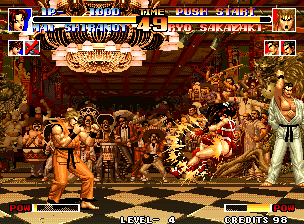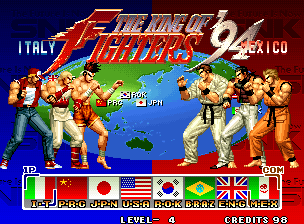Overview
The King of Fighters '94 is a 2D tag-team fighting game developed and released by SNK for arcades (running Neo Geo MVS hardware) on August 25, 1994. It was subsequently released for the Neo Geo AES and Neo Geo CD later that year.
The first in a long-running series of fighting games, The King of Fighters '94 was developed as a crossover featuring not only characters from SNK's other fighting franchises (Fatal Fury and Art of Fighting), but also from some of SNK's pre-Neo Geo games (Ikari Warriors and Psycho Soldier). It introduces the series's standard Team Battle System, a form of "team elimination" matches where players form a team of three characters and must fight subsequent one-on-one rounds until all enemy opponents are knocked out.
The story of the game revolves a revival of the "King of Fighters" martial arts tournament, hosted by the mysterious "R" (later revealed to be ruthless arms dealer Rugal Bernstein), to bring together the strongest fighters from all over the world. Along with new rules for teams, this tournament also introduces a mysterious team of newcomers (led by pyrokinetic Japanese high school student Kyo Kusanagi, who serves as the series' main protagonist).
The game received yearly sequels between 1995 and 2003, followed by additional numbered sequels and spin-offs.
Ports & Re-releases
Unlike later games in the series, The King of Fighters '94 did not receive a port to other consoles at that era. However, it later received a Japanese-exclusive enhanced port to the PlayStation 2 (dubbed The King of Fighters '94 Re-Bout) on December 28, 2004. Made for the game's 10th anniversary, Re-Bout adds higher-definition graphics, 3D backgrounds, an arranged soundtrack, the Team Edit option from the later games, and online multiplayer.
The original game later received numerous digital re-releases, first for the Wii (by D4, as a Virtual Console title) in Japan on November 6, 2007, in Europe on November 23, 2007, and in North America on January 7, 2008. It was then digitally re-released (as a NEOGEO Station title) for the PlayStation 3, PlayStation Vita, and PlayStation Portable worldwide on December 21, 2010. It was later digitally re-released by HAMSTER as part of the ACA NeoGeo series for the PlayStation 4 (on October 27, 2016), Xbox One (on March 9, 2017), Nintendo Switch (on March 16, 2017), and PC (via Microsoft Store on December 15, 2017).
The original game was also included in two compilations (both for the PlayStation 2, Wii, and PlayStation Portable): SNK Arcade Classics Vol. 1 and The King of Fighters Collection: The Orochi Saga. As the Japanese version of the King of Fighters Collection is part of the NeoGeo Online Collection series, that version of the game features online multiplayer.
Gameplay

The King of Fighters '94 plays like a traditional 2D fighting game, using four buttons (Light Punch, Light Kick, Strong Punch, and Strong Kick).
In addition to the traditional match condition of best-of-three rounds between two fighters (which can be enabled by the arcade operator or in the home version), the game's main match condition is having teams of three competing against each-other in single-elimination rounds. The winner of each fight receives some of their vitality back and goes on to fight the next person on the opposing team, continuing until all fighters from one team are eliminated.
Advanced Techniques
- Holding forward on the joystick wile pressing Strong Punch at a close distance can make the fighter perform an unblockable throw. This can also be used to punish the Attack Avoidance manuever.
- Double-tapping forward or backward on the joystick can make the fighter perform a hopping dash, allowing players to close (or widen) the gap between both fighters. However, it leaves them vulnerable to attacks.
- Pressing both Light buttons simultaneously can make the fighter perform a standing dodge (called an "Attack Avoidance"), shifting the player's fighter to the background to avoid attacks (including projectiles). However, it leaves them vulnerable to throws.
- Pressing both Strong buttons simultaneously can make the fighter perform a knockdown attack (called a "High Damage Attack") that pushes away opponents (knocking them down in the process). While stronger than normal Strong attacks, it has a lengthy animation that leaves the fighter vulnerable to attacks.
- When in a dizzied state (after being damaged by numerous consecutive attacks), pressing Light Kick and both Punch buttons simultaneously while close to the fighter's allies (and at least one of those allies have not fought in the match) can make that fighter perform an assist attack, where one of those allies jumps in for a knockdown strike (buying the fighter time to recover).
Power Gauge
The Power Gauge system takes elements from both the Art of Fighting and Fatal Fury games. Each fighter has their own Power Gauge on the bottom of the screen, which is automatically charged by blocking attacks and receiving damage. Players can manually affect both Power Gauges using two special techniques:
- Holding down Light Kick and both Punch buttons simultaneously can make the fighter perform a "Power Charge", allowing them to charge the fighter's Power Gauge manually over time at a fast rate. However, it leaves them vulnerable to attacks.
- Pressing Strong Punch from a faraway distance can make the fighter perform a Taunt, depleting part of the enemy's Power Gauge. However, it leaves them vulnerable to attacks.
Once the Power Gauge is filled, the player enters a "MAX" state (as indicated by the fighter flashing bright) where their basic attacks become stronger for a short time. After a short amount of time, the MAX state ends and their Power Gauge is fully depleted.
Players can also perform a hidden character-specific technique (the "Super Special Move") that can only be performed either in the "MAX" state (ending the "MAX" state early) or when the fighter's vitality is low (as shown by a blinking life bar). Performing the technique while both conditions are valid still ends the "MAX" state early.
Characters

The game includes 24 playable characters split into 8 teams of three. Unlike in the game's numerous sequels, players in this game can not mix-and-match characters between teams. 14 of these characters return from other SNK games.
Though these groups represent different countries around the world, there are some teams where none of the character's nationalities match the team's country (most notably Italy, Mexico, and Brazil).
Japan (Japan Team)
Italy (Fatal Fury Team)
Mexico (Art of Fighting Team)
Brazil (Ikari Warriors Team)
China (Psycho Soldier Team)
England (Women Fighters Team)
U.S.A. (American Sports Team)
Korea (Korea Team)
Other
- Rugal Bernstein (final boss, unplayable) - Does not fight under a team. Must be defeated twice, with a more powerful version as his second "stock". Uses his black panther Rodem for assist attacks.
Log in to comment